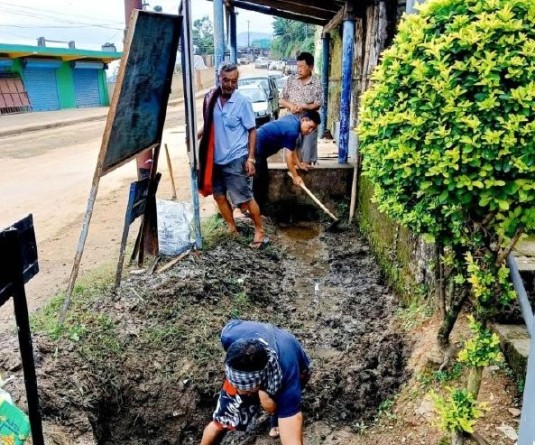
NT Kikon
Director of Wondang-ki Charitable Foundation, Dimapur
INTRODUCTION The Customary Practice of adoption by the Nagas differed from clan to clan, village to village and from one tribe to the other. The uniqueness of the customary practices of the Naga tribes was based on mutual understanding where the value of family bond and relationship from down the generation were upheld. From time immemorial ADOPTION, FOSTER PARENTING and GUARDIANSHIP WERE PREVALENT AMONG THE NAGAS. Both female and male were adopted, however, adoption of a male child involved issues related to continuity of family linage and an inheritance. Hence it was necessary for the adoptive parents to obtain consent from the family and the clan.
VARIOUS ADOPTION PRACTICED:
1. Adoption within the closest kin - among the siblings, when there were unfortunate few who were issueless, to do away the shame and sorrow caused due to their inability to have an offspring, one of the brother and his wife gave birth to a child who is given to the issueless couple to adopt the child.
2. Incase of Tragedy involving the death of both parents - the closest kin of either parents get the custody (as foster parents), which is decided in a family discussion. However, the prerogative rights of the custody lies with the father's family. When, there were no dose relatives who can accommodate such children, the clan men came forward to take care of such children.
3. Incase of divorce involving minors- the family decides who should have the custody of these children. However, when minors are involved, the child remained with the mother until the weaning period. During these times the husband is responsible to provide maintenance of the child.
4. Incase of a child born out of wed-lock- if the father of the child is ascertained, the child is given to the father. In such circumstances, the father gave the child for adoption within the relation especially if there were issueless couple in the family if not the child is given for adoption within the community.
5. Adoption of an orphan - orphans were adopted or fostered by the closest kin. Yet, when there were no close kin who can take up the responsibility to take care of such children, the clan men consented to giving the child for adoption.
6. Adoption for Service was also prevalent among the Naga tribes. In this type of an adoption a destitute or an orphan boy can be brought up by a man to help him in his cultivation and other domestic affairs. When the adoptee renders faithful service he earned the favor of the adoptive father who owns him as his own son. In such cases, the adoptee is helped to get married, construct a house for him in his own land and allows him to cultivate a portion of the adoptive father's land. Then, he becomes a member of the adoptive family and a member of his father's clan. Having a large number of adopted sons was of an importance which signifies wealth and position in the community.
7. Another form of adoption practiced was when a young man, without leaving his clan, would call an elderly man “father” out of respect. He then, visited his “father” along with his friends and presented him a spear, a parcel of salt and some meat as a token of gift. They would all feast together and from that day onwards addressed each other as “father” and “son” and attended each other’s feasts and ceremonies. Therefore, the son was given a field of the father’s clan for cultivation.
Adoption of a boy was very significant with the purpose: - To continue the lineage of the adoptive father - A son was adopted for inheritance of the family property. - To look after the aged parents.
8. Foster parenting was common, especially when a family has too many children or economically unable to support the family. In such cases, children were sent to live in their close kin’s family. When they grow up and become independent they return to their parents yet remained very closely attached to their fostered parents.
9. It is also said that, when a mother give birth to a twine child, one of the childe has to be given away to another village with the belief that, if the children are together one of them may not live long.
10. Guardianship of an orphaned child is a social obligation to the family. In a family where the eldest son is grown up he took up the responsibility of his father to take care of the younger siblings supported by the closet kin of the family. However, if the children are minor and there were no close relatives the clan flock came forward and decided who among them should take care of these children. Since, to leave these children unattended is a disgrace to the clan, such children were never neglected.
PREVALENT SUPERSTITION & FEAR INVOLVED IN ADOPTING A BOY:
- There is a belief that an adopted son is like a parasite that will dominate the adoptive family in course of time. - When a son is adopted and his offspring multiplies the adoptive parent’s family degenerates.
- Apprehension that the male child will one day go back to his roots CONCLUSION: Time has come when we have to seriously decide whether we must uphold the customary practice of adoption or with the change of time, approach and present trend move forward with the rest of the country on Legal Adoption which provides safety to all involved in adoption, such as the adopted child, adoptive parents and the biological parents.
(An extract from 15 tribes’ input on adoption from their tribe’s context. Tribes include Angami, Ao, Chang, Chakhesang, Khiamniungan, Konyak, Lotha, Pochury, Phom, Rengma, Rongmei, Sangtam, Sumi, Yimchunger and Zeliang)




